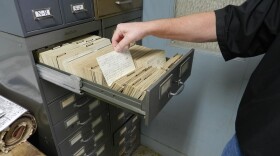Ann Arbor is approaching a milestone of sorts. The city is replacing the last of its lead connections in the water system.
Ann Arbor city officials say they never allowed full lead service lines, the water pipes buried underground that connect homes to the water main.
Where are lead water pipes in Michigan? Here’s our best guess
But, like many older cities, Ann Arbor does have “lead goosenecks” – small sections of malleable lead pipe no more than two feet long. These curved goosenecks made it easier to connect the service line to the water main. (The public utility in Tacoma, WA has a great graphic here.)
At one time, roughly 2,000 Ann Arbor homes had lead gooseneck connections. By last spring, it was down to 118.
But by the end of this month, water treatment services manager Brian Steglitz says they’ll pull out the last three, leaving no record of lead pipes in the city’s water system.
“Our customers are fortunate to be living in a community that doesn’t have a lead issue. So we’re all very thankful for that because we feel for some of our peers who are struggling with this issue elsewhere,” Steglitz said.
State regulators have been telling water operators the U.S. EPA recently clarified its position on lead goosenecks.
A memo from MDEQ to water systems says cities should include homes with lead goosenecks in their compliance testing. Homes with full lead service lines should be given priority, the memo says, followed by partial lead service lines and then those with lead goosenecks. In this scenario, a lead pipe counts as a lead pipe for compliance testing, even if it is only 18 to 24 inches long. It still poses a risk.
The EPA declined an interview for this story. A spokesperson did not say the agency clarified the rule, saying the definition of a lead service line is already in the federal Lead and Copper Rule. "Lead service line means a service line made of lead which connects the water main to the building inlet and any pigtail, gooseneck or other fitting which is connected to such lead line," the EPA spokesperson wrote.
But the EPA offical also pointed to a memo the director of the Office of Ground Water & Drinking Water Peter Grevatt issued in October, 2016.The memo urges water systems and states to "work together to ensure robust implementation of the current" Lead and Copper Rule. The memo does not directly mention goosenecks.
Now, because Ann Arbor soon won’t have lead goosenecks, they won’t have to worry about tracking them down for compliance testing the city has to do later this summer. But some other Michigan cities, that otherwise don’t have full lead service lines, may have to.
**This post has been updated to reflect a written response for U.S. EPA.












